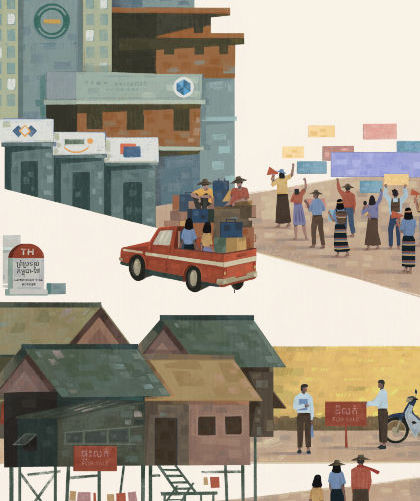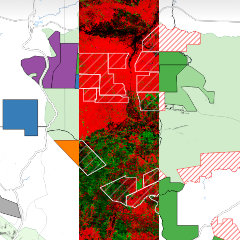On World Day Against Child Labour, LICADHO Urges Authorities To End Root Causes of Child Labour
Published on 11 June 2014LICADHO will mark World Day Against Child Labour 2014 by organizing community events in two locations: Sangkat Dang Tung, Koh Kong; and Stung Haov district, Preah Sihanouk. The aim of these events is to raise awareness of child labour in various sectors and to encourage communities to raise critical questions, and offer suggestions to local authorities on how to end child labour. World Day Against Child Labour officially falls on June 12.
In Sangkat Dang Tung, Koh Kong, LICADHO will cooperate with a local CPG to facilitate a march on June 12 comprising at least 200 people to raise awareness of child labour in the garment and fishing industries. Following that, CPGs plan to host a public forum and a theater performance with an audience of at least 500 participants.
In Stung Haov district, Preah Sihanouk, LICADHO will organize a community event on June 15 in cooperation with the provincial Department of Labour and Vocational Training. Approximately 500 people from three communes are expected to join. Participants will march one-two kilometers accompanied by traditional music (Chay Yam), and then participate in a public forum and theater performance. The focus will be on child labourers in garment factories and fishing.
Background on Child Labour
In 2012, the ILO found that there were 755,245 working children in Cambodia. Of this number, 429,380 (56.9 percent) classified as child labourers, while 236,498 (31.3 percent) worked in hazardous conditions, where they were exposed to harmful chemical substances or tools.
Child labour threatens the fundamental rights of children to survive with dignity, develop intellectually and physically, be protected from abuse, and participate in his/her community. Child labourers work in a variety of areas: domestic work, garment factories, garbage collecting, fishing, agriculture, brick factories, and construction, among others. While some forms of child labour are more hazardous, most require children to work long hours that could be spent at school and nurturing relationships with peers, teachers and family. Many child domestic workers, for example, start working very early and end late at night. Since their work takes place behind closed doors, it is difficult for authorities and NGOs to monitor and safeguard their well-being.
In cases where children work in hazardous conditions, there is a high risk of work-related injuries from dangerous machinery or chemical substances.
The high number of child labourers, especially those working in hazardous conditions, is a clear breach of Cambodia’s Labour Law that prohibits anyone younger than 18 years old from working in hazardous conditions (Provision No. 2 in article 177). Without proper implementation and enforcement, authorities allow companies and employers to exploit children without facing legal consequences.
Even in less hazardous working conditions, child labourers are vulnerable to physical, sexual, verbal and emotional abuse by older employers and co-workers. However child laborers are often unaware of their legal rights and may fear that the courts will penalize them for illegal labor rather than address the criminal complaint. They may also be unable or daunted by the process of filing a legal complaint against their abusers which requires a legal guardian to act on their behalf.
“Child labour not only exploits children, but is itself a symptom of broader societal problems,” LICADHO Director Naly Pilorge says. “Specifically, authorities remain slow to implement and enforce labour-related laws and regulations. This has to change.”Parents also bear responsibility for promoting child labour practice. In some households, parents adhere to traditional customs that require children to share the burden of supporting the family. As such, they do not consider it wrong when children drop out of school to work. In other cases, parents overwhelmed by poverty, unemployment, debt, health issues, and other unforeseen crises, believe that they have no choice but to ask their children to find a job to help support their family.
Cambodia’s high rate of land eviction also directly perpetuates child labour. Since 2000, LICADHO estimates that at least 500,000 people in roughly half the country have been affected by state-involved land conflicts. Many children from evicted families drop out of school because of inadequate facilities at their relocation site. Others start working because their parents need help earning money after losing their former livelihoods.
LICADHO urges authorities to focus not just on eradicating types of child labour, but also to address its underlying causes. LICADHO calls for the authorities to:
- Improve labour inspections to ensure that there are no children under 18 working in hazardous conditions, or beyond the hours appropriate for their age, as outlined by the ILO. Authorities should also severely penalize employers who exploit child labour.
- Review the current labour-related laws and regulations to guarantee that all types of child labourers are protected. LICADHO observes that the Ministry of Labour and Vocational Training has yet to issue a Prakas ensuring the safety of child domestic workers.
- Put an end to illegal evictions that disrupt the livelihood of families, and result in children dropping out of school to find work.
- Ensure that evicted families are fairly compensated, and that relocation sites include access to adequate schools and health centers for affected children.
- Prioritize awareness campaigns on child labour at the local level. While infrastructural development is important, there is an equally urgent need for authorities to educate parents and communities on the ways that child labour threatens the rights of children, and how it is not the long-term solution to poverty.
“Eradicating child labor and its root causes is not just an issue of child rights,” Child Rights Coordinator Kong Socheat says. “If many children continue to drop out of school and work, Cambodia’s long-term social and economic development will be jeopardized. Child labour practices can only continue to the extent that authorities, employers, parents, children and communities continue to believe that it is not an urgent issue, and even justifiable on grounds of profit, poverty and traditional customs.”
* The International Labour Organization (ILO) defines child labour as:
a) Children aged 5–11 years engaged in any economic activity for one hour or more a week.
b) Children aged 12–14 years engaged in permissible (non-hazardous) economic activity for more than 12 hours a week.
c) Children aged 12–14 years engaged in work for fewer than 12 hours a week but working in designated hazardous industries and occupations.
d) Children aged 15–17 years engaged in economic activity for more than 48 hours in a week.
e) Children aged 15–17 years engaged in economic activity for 48 or fewer hours in a week but engaged in designated hazardous industries and occupations.
For more information, please contact:
▪ Ms. Naly Pilorge, LICADHO Director, 012 803 650 [French, English]
▪ Mr. Kong Socheat, LICADHO Children’s Rights Coordinator, 012 536 300 [ Khmer]
PDF: Download full statement in English - Download full statement in Khmer
MP3: Listen to audio version in Khmer
- Related Material
- Topics
- Children's rights Forced labour & debt bondage






